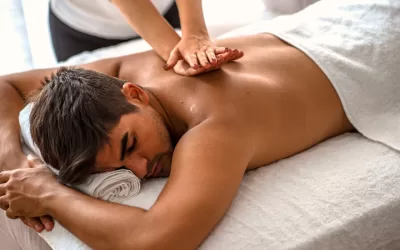Embarking on a journey of physical fitness and athletic prowess often brings with it the exhilaration of achievement and the thrill of pushing personal boundaries. However, the path of an active lifestyle is not without its challenges, with sports injuries being an inevitable aspect of the journey. When faced with the need for recovery, therapeutic massage emerges as a beacon of healing. Yet, the effectiveness of this healing touch lies in choosing the right therapeutic massage tailored to your specific sports injury.
In this comprehensive guide, we delve into the essential “7 Steps In Choosing The Right Therapeutic Massage For Your Sports Injury,” providing you with a roadmap to navigate the diverse landscape of massage therapies, empowering you to make informed decisions crucial for a swift and effective recovery. Whether you’re a seasoned athlete or a weekend warrior, understanding these steps will guide you towards a tailored and rejuvenating massage experience, accelerating your journey back to peak physical performance.
Step #1: Identify The Type Of Sports Injury
Understanding the intricacies of your sports injury is the foundational step in choosing the right therapeutic massage for effective rehabilitation. In the realm of sports injuries, no two are precisely alike. From muscle strains and ligament sprains to joint inflammation, each injury demands a nuanced approach to recovery.
Begin by conducting a thorough self-assessment or, preferably, seek guidance from a healthcare professional, such as a physiotherapist or sports medicine specialist. Pinpoint the specific areas of pain, recognize any limitations in movement, and identify the nature of the injury—whether it’s an acute trauma or a chronic condition developed over time.
By precisely identifying the type of sports injury you’re dealing with, you set the stage for a targeted and tailored massage therapy. Different injuries respond better to specific massage techniques, so this initial step acts as a compass, guiding you toward the most appropriate modalities for your unique situation.
Step #2: Consult With A Healthcare Professional
In the pursuit of optimal recovery from a sports injury, the importance of seeking guidance from a healthcare professional cannot be overstated. Step #2 in our guide emphasizes the significance of consulting with experts who can provide valuable insights into your injury and help you make informed decisions about the appropriate therapeutic massage.
Physiotherapists, sports medicine specialists, and orthopedic doctors are trained to assess and diagnose sports injuries comprehensively. Schedule an appointment to discuss your condition, sharing details such as when the injury occurred, the circumstances surrounding it, and any previous attempts at treatment. These professionals can offer a precise diagnosis, identifying the specific structures affected and the extent of the damage.
During the consultation, inquire about the recommended course of action for recovery, including the role of therapeutic massage in your treatment plan. Healthcare professionals often have established networks and can provide referrals to licensed massage therapists with expertise in sports injury rehabilitation. This collaborative approach ensures that your massage therapy aligns seamlessly with the broader strategy for your recovery.
Furthermore, consulting with a healthcare professional allows for a holistic understanding of your overall health and fitness levels. This comprehensive insight enables the customization of your massage therapy to address not only the immediate injury but also any underlying factors that may contribute to its recurrence.
Step #3: Research Massage Modalities
As you progress through the journey of selecting the right therapeutic massage for your sports injury, Step #3 invites you to delve into the diverse world of massage modalities. Understanding the various techniques available will empower you to make an informed choice that aligns with the specific needs of your injury and enhances the effectiveness of your rehabilitation.
Common massage modalities encompass a spectrum of approaches, each designed to address specific aspects of musculoskeletal health. Here are some key modalities to consider:
- Swedish Massage: Known for its gentle and relaxing strokes, Swedish massage promotes overall relaxation and improved circulation. While it may not be as intensive as other modalities, it can still contribute to the recovery process by reducing muscle tension and stress.
- Deep Tissue Massage: This modality involves applying firm pressure to reach deeper layers of muscles and connective tissue. Deep tissue massage is particularly beneficial for addressing chronic muscle tension and aiding in the recovery of sports-related injuries.
- Sports Massage: Tailored for athletes and active individuals, sports massage focuses on preventing and treating injuries. It often includes a combination of techniques to enhance flexibility, reduce muscle soreness, and promote faster recovery.
- Myofascial Release: This technique targets the fascia, the connective tissue that surrounds muscles. Myofascial release aims to alleviate restrictions and improve mobility, making it valuable for conditions involving restricted movement or chronic pain.
- Trigger Point Therapy: Identifying and releasing trigger points—localized areas of muscle tightness—characterize this modality. Trigger point therapy can be effective in alleviating pain associated with specific injuries or muscle imbalances.
Take the time to research and understand the principles behind each modality. Consider how the unique characteristics of your sports injury align with the goals and techniques of these massages.
Step #4: Find A Licensed And Certified Massage Therapist
Once armed with knowledge about your sports injury and an understanding of massage modalities, the next critical step is to find a licensed and certified massage therapist. Choosing a qualified professional ensures that you receive expert care tailored to your specific needs.
Licensed massage therapists have undergone rigorous training, demonstrating their proficiency in various massage techniques. Certification further validates their commitment to maintaining industry standards and ethical practices. To locate a suitable therapist, consider seeking recommendations from healthcare professionals, friends, or online reviews.
A licensed and certified massage therapist brings a wealth of knowledge and skill to your recovery journey. They will conduct a thorough assessment of your injury, discuss your medical history, and tailor the massage session to address your unique needs. This step is pivotal in ensuring the safety and efficacy of the therapeutic massage, contributing significantly to your overall well-being and the success of your rehabilitation.
Step #5: Discuss Your Injury With The Massage Therapist
Open communication with your chosen massage therapist is essential for a successful therapeutic experience. In this step, share detailed information about your sports injury, including the specific areas of discomfort, any limitations in movement, and your overall health history. By providing a comprehensive overview, you enable the massage therapist to tailor their approach, ensuring that the session addresses your injury’s unique aspects.
This dialogue establishes a collaborative relationship, allowing the therapist to adapt their techniques to your individual needs. Your input, coupled with the therapist’s expertise, creates a personalized treatment plan focused on alleviating pain, promoting recovery, and enhancing overall well-being. Step #5 serves as a crucial bridge between your understanding of the injury and the therapist’s ability to implement targeted and effective massage strategies.
Step #6: Ask About Experience And Specialization
In the quest for the right therapeutic massage, it’s crucial to inquire about the massage therapist’s experience and specialization, particularly in addressing sports injuries. Ask about their background, training, and the duration of their practice, as well as any specific expertise in dealing with athletic rehabilitation. A therapist with a focus on sports massage or a history of successfully treating similar conditions is well-equipped to understand the unique challenges associated with sports injuries. This step ensures that you entrust your recovery to a skilled professional, enhancing the likelihood of positive outcomes.
Step #7: Consider Personal Preferences
In the final step of selecting the right therapeutic massage, factor in your personal preferences. Assess elements such as the therapist’s communication style, the ambiance of the massage space, and your overall comfort. A positive and relaxing environment can significantly contribute to the effectiveness of the massage session. By aligning your personal preferences with the therapeutic experience, Step #7 ensures that your chosen massage therapy not only addresses your sports injury but also enhances your overall well-being.
Conclusion
Embarking on the journey of recovery from a sports injury is a multifaceted endeavor, and the quest for the right therapeutic massage plays a pivotal role in this process. The “7 Steps In Choosing The Right Therapeutic Massage For Your Sports Injury” serve as a comprehensive guide, offering a roadmap to navigate the nuanced landscape of massage therapies.
From identifying the type of sports injury in Step #1 to considering personal preferences in Step #7, each stage contributes to a holistic approach that ensures your chosen massage therapy aligns seamlessly with your unique needs and accelerates the path to healing.
These steps underscore the importance of collaboration, communication, and informed decision-making. Consulting with healthcare professionals, researching massage modalities, and selecting licensed therapists contribute to a well-rounded strategy for sports injury rehabilitation.
As you embrace these steps, remember that your journey is as individual as your injury. The right therapeutic massage is not merely a treatment; it becomes a tailored experience aimed at rejuvenating your body, restoring balance, and enhancing overall well-being.
May this guide empower you to make choices that resonate with your healing goals, guiding you toward a future where strength, flexibility, and vitality characterize your physical endeavors. In the realm of sports injury recovery, the right therapeutic massage becomes a crucial ally, supporting you on the path to renewed vigor and athletic prowess.
Harnessing The Power Of Therapeutic Massage For Sports Injuries: Your Path To Recovery!
Are you struggling with the aftermath of a sports injury, feeling hampered by pain and limited mobility? Turn to the experts at MedicinEvolution, where the healing touch of Therapeutic Massage is expertly applied to target your sports-related injuries, offering a path to effective recovery! Wave goodbye to the discomfort caused by strained muscles, overexertion, and repetitive sports movements—as MedicinEvolution taps into the root causes of your injury, facilitating a transformative healing process. With their skilled approach, you’ll experience a remarkable turnaround from the pain that once hindered your athletic performance!
Whether you’re grappling with persistent pain, stiffness, or the frustrating limitations of a sports injury, their specialized methods are designed to meet the specific needs of your condition. Don’t let injury setbacks control your athletic journey—take the reins and schedule your session with MedicinEvolution today! Step into the realm of Therapeutic Massage and embark on a road to a more active, pain-free life. Your body—and your athletic aspirations—will be grateful!





